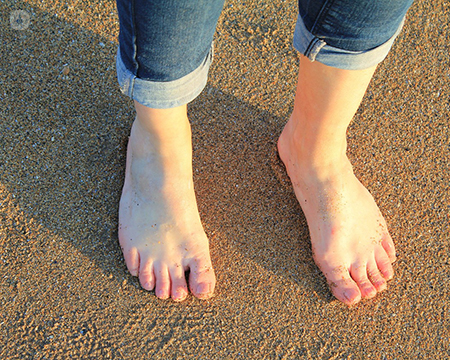A quick guide to bunions
Written in association with:In his latest online article, renowned consultant orthopaedic foot and ankle surgeon Mr Shelain Patel provides a concise overview of bunions, addressing their causes, recommended precautions, available treatments, and the necessity of intervention.

Causes of bunions:
Bunions, those bony protrusions at the base of the big toe, arise due to various factors, including:
- Genetics: A familial predisposition to bunions is common.
- Footwear: The habitual use of constrictive, narrow shoes can contribute to the development of bunions.
- Foot mechanics: Irregular gait patterns, such as overpronation, may exert undue stress on the big toe joint.
- Injuries: Past foot injuries, even seemingly minor ones, can trigger bunion formation.
- Medical conditions: Certain medical conditions, such as rheumatoid arthritis, may elevate susceptibility to bunions.
Precautions for bunion sufferers:
For those already afflicted with bunions, prudent measures can mitigate discomfort and progression:
- Footwear selection: Opt for footwear that accommodates your feet comfortably, characterised by a wide toe box and proper arch support.
- High heels abstinence: High-heeled shoes exacerbate bunion symptoms by increasing the angle of the big toe joint and should be avoided.
- Pressure management: Activities that place undue pressure on the toes, such as extended periods of standing, should be minimised.
- Consultation: Seek professional guidance rather than resorting to self-treatment, including over-the-counter products.
Treatment options for bunions:
Several strategies are available to address bunions, tailored to individual needs:
- Footwear modification: Wearing well-fitting, supportive shoes can alleviate discomfort.
- Orthotic devices: Toe alignment splints and insoles can redistribute pressure and improve gait.
- Medications: Over-the-counter pain relievers or prescription medications may manage pain and inflammation.
- Physical therapy: Targeted exercises can enhance muscle strength and correct gait abnormalities.
- Injections: In select cases, corticosteroid injections may be administered to reduce inflammation and pain if arthritis is co-existing.
- Surgical intervention: When conservative methods prove ineffective and bunions significantly impact daily life, surgical procedures, ranging from realignment to joint fusion, may be considered.
Necessity of treatment:
The imperative for bunion treatment varies. Individuals with mild symptoms and minimal hindrance to daily activities may find relief through lifestyle adjustments. However, those experiencing persistent pain, mobility restrictions, or worsening conditions should seek professional evaluation. Early intervention can prevent the need for surgical intervention.
In conclusion, while bunions are a prevalent foot ailment, they are manageable with appropriate care. By selecting comfortable footwear, adhering to recommended precautions, and consulting with healthcare professionals, when necessary, individuals can maintain optimal foot health. Remember, your feet deserve the utmost attention, and timely intervention can avert more severe complications.
If you would like to book a consultation with Mr Shelain Patel, you can do so today via his Top Doctors profile.


